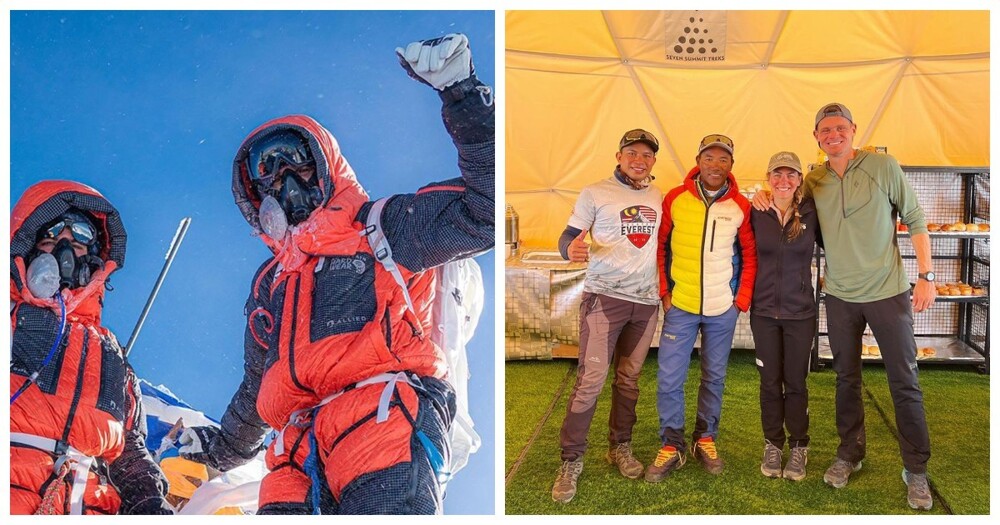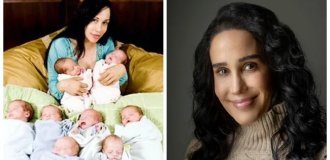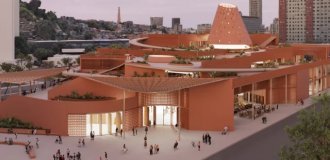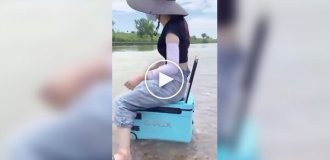Deaf climbers conquered Everest and made history (3 photos + 1 video)
How can a deaf climber communicate with a partner or give a sign, if he has an ice ax in his hands? Do guides refuse to work with hard of hearing? What happens if you cannot see at night what Do they give you signs with gestures? These are just some of the questions that discuss American climbers Scott Lehmann and Shaina Unger on their YouTube channel. They both suffer from deafness, but stubbornly continue to conquer tops of the highest mountains in the world. 
May 22 Unger and Lehmann joined the list of deaf climbers, conquered Everest. This list is very small: before them there were only two people, they became the third and fourth. It should be noted that Shayna Unger is the first woman with deafness who managed to climb this difficult top.
By coincidence, on the way to the top of Unger and Lehmann met the Malaysian climber Muhammad Khawari Hashimi, who took second in the aforementioned list, slightly ahead of Lehmann and Unger. He climbed Everest on May 18 and posted on social media a photograph of him holding the Malaysian flag with a proud smile.
The fact that three deaf climbers at once climbed the most highest mountain of the world with a difference of only a few days - in just a few years after the Supreme Court of Nepal lifted the ban on climbing there by disabled climbers - caused a wave of pride in the global community of the deaf and hard of hearing.
According to the World Federation of the Deaf, there are 70 million people are deaf and speak more than 300 various sign languages. Unger and Lehmann are among them. TV channel CNN interviewed them via Zoom in American Sign Language (ASL).
Previously, only one deaf person was known to have raised Everest, Japanese climber Satoshi Tamura, a skier who succeeded on the third attempt in 2016.
Nepal then announced that it would no longer issue permits climbing for people with disabilities. This decision led infuriated disabled climbers, including Hari Budha Magar, a native of Nepal, who received a double amputation while serving in Afghanistan. A coalition was organized to fight against this ban, and in 2018 it was canceled. Magar successfully summited Everest 19 May of this year, becoming the first person to have a double amputation above the knee, made the ascent.
Shaina Unger (left) and Scott Lehmann on the summit of Everest 
Unger and Lehmann have been a couple since high school, but they took up mountain climbing only in 2015, when they conquered Kilimanjaro.
Lehmann had much more experience after touring the country with friends after graduating from Gallaudet, the world's only humanitarian university for the deaf and hard of hearing. He fell in love with climbing, but was frustrated by the lack of resources available in his native sign language ASL.
He signed up for the course, but the instructor explained that he you will have to hire and pay for the services of an interpreter yourself, and then hire an interpreter who will accompany him on every expedition. Then Lehmann turned to YouTube for information, but most of the videos do not there were subtitles, and the automatic subtitles were of very poor quality. IN Basically, he said, he learned by trial and error by watching other climbers and copying them. He then taught rock climbing to his life partner, Shaina Unger.
Usually the couple uses an app to translate their voice into Big text to communicate with guides and other climbers, but telephone the signal at high altitudes is at least unreliable. Even such a simple thing like typing at 7600 meters is a challenge - To use the touch screen, you have to take off your gloves, which is risky in such cold temperatures.
Unger and Lehmann proceeded from the assumption that to conquer Everest they will have to use no technology, so decided to learn how to communicate, doing without them, as far as it Maybe.
Before climbing, they worked in advance with their Sherpa guides to teach them basic ASL sign language and agree on visual cues and cues that they all might use. By the third week of the joint ascent, the couple and their Sherpas were able to easily interact without using the app or recording something on paper.
And this preliminary preparation helped a lot during climbing! Closer to the top, Lehmann's mask filled with ice, and he panicked. However, he managed to contact his Sherpa, who quickly repaired the mask and returned the group to the desired direction.
We had to overcome many different obstacles, hto get to Everest, so when we reached the top, then felt that they had overcome all the difficulties, says Shaina Unger. - We really proud of themselves.
At Everest Base Camp, Unger and Lehmann became friends with Hashim, Malaysian mountaineer. He saw the couple interacting between with gestures, and approached to get acquainted. Even though Hashim does not know ASL, he, Lehmann and Unger found a way out, using international sign language.
Muhammad Khawari Hashim (far left), Nepalese Sherpa guide and Everest record holder Kami Rita, Shaina Unger and Scott Lehmann in the base camp 
Hashim pushed the pair to their peak on May 18, but no one has seen him since. saw. He disappeared the next day while descending from the summit on the fourth camp. The governments of Malaysia and Nepal provided support for the search operation, which was eventually abandoned on 6 June.
This year, as Nepal issued more permits on the ascent than ever, there have been many tragedies. Confirmed that twelve climbers died in the 2023 season, five more, including Khavari, are missing.
Of course, we know that mountaineering comes with risks - says Unger. “But it happened to our friend and to our community.” deaf, and it's not easy for us.
Lehmann and Unger are not going to stop. They strive become the first deaf climbers to conquer the Seven Summits - the most high mountains on every continent. Only 460 people are known to have succeeded walk this path.
So far, they have successfully climbed Everest, Kilimanjaro, Aconagua and Denali, the highest peaks in South and North America, respectively.
With the right attitude and the right preparation the ascent is accessible to deaf and hard of hearing people,” says Lehmann. - People with disabilities can do this if very want.
He also talks about how he hopes to inspire the deaf and hearing-impaired children: what will they think when they see that two deaf adults conquered the highest mountain in the world?
Talking about his goal to inspire the deaf and hard of hearing, Lehmann repeatedly uses the "dream" sign, which looks like an inflated balloon, but he inflates it until it becomes bigger and bigger, almost his size. It's hard to translate it concept from sign language to normal. But, as climbing experience shows Lehmann and Unger, ambition makes sense in any language.





















